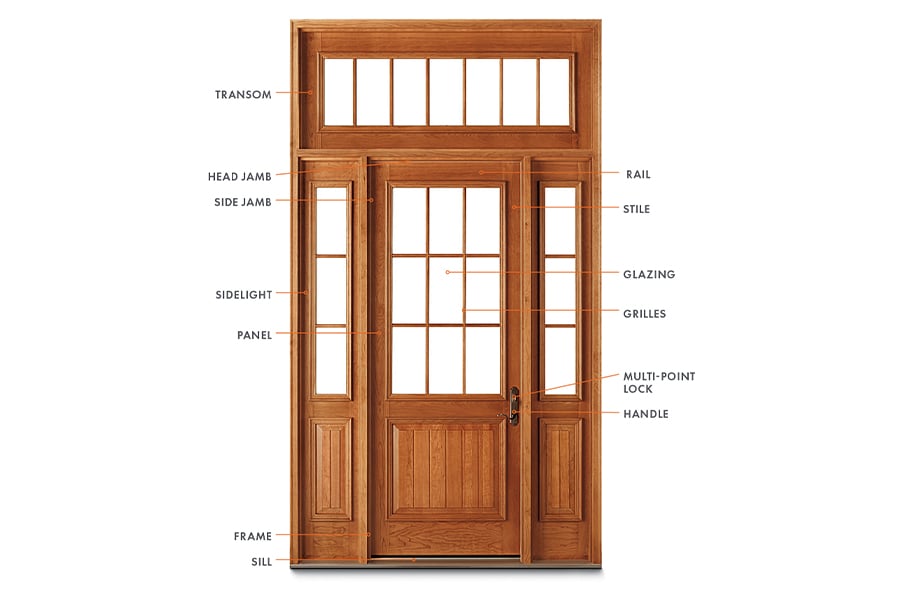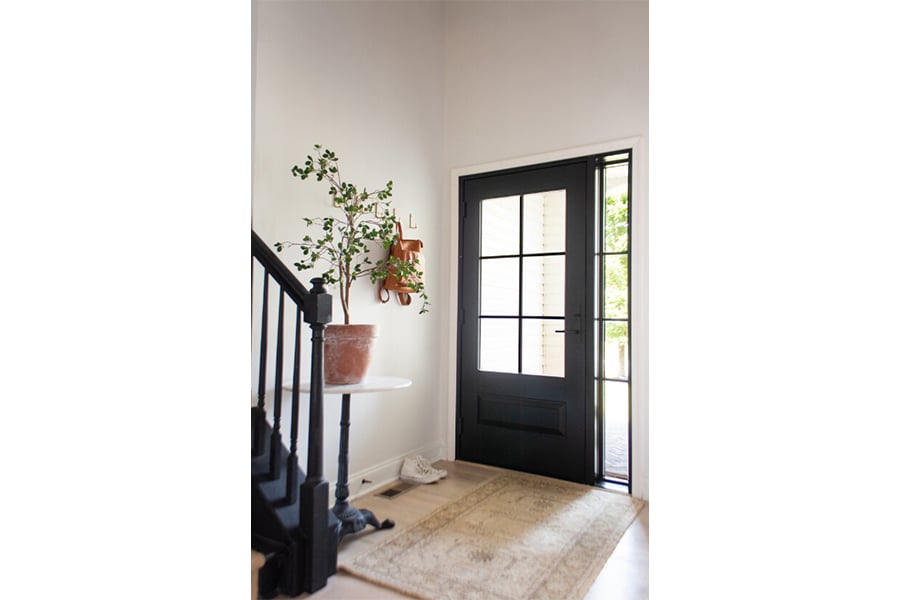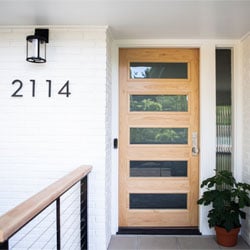Tips
Parts of a front door

Parts of a door
Knowing what each part of a door is called and where it’s located makes your project easier, whether you’re measuring a door for replacement, ordering a new part, or just trying to communicate effectively with your contractor or builder.

- Rough opening: The space in the wall where the door is installed. Measuring the rough opening is a key step when measuring to order a new door.
- Panel: This is probably what comes to mind when you imagine a front door. It’s the part of the door that swings open (operates). It’s assembled of components like rails, stiles, glass (if there’s a window), and more. Measuring the panel size can help you order the right size replacement door.
- Frame: The outer structure of the door that holds the panel in place. When you close your door, the panel fits into the frame and the frame fits into the rough opening. It’s important to know your door’s frame size when measuring for replacement.
- Side jamb: The side parts of the door frame. When measuring the width of a door frame, you would measure from outer side jamb to outer side jamb.
- Head jamb: The top of the door frame. When measuring the height of a door frame, you’d start at the top edge of the head jamb.
- Sill: The horizontal piece at the bottom of a door frame. When measuring the height of a door frame, you’d extend your measurement beyond the sill all the way down to the sub-floor, which is the floor below your finished floor.
- Sidelight: A window or windows next to the door that bring light and beauty to your entryway. A sidelight will be installed in the same rough opening as the door.
- Transom: A window that’s above the door and was historically intended to bring in fresh air while the door was closed. Transoms are installed in the same rough opening as the door.
- Glazing: This word can have two meanings: 1) glass in a door panel or window sash, or 2) the act of installing glass in a door panel or window sash.
- Grilles (also called muntins and dividers): Bars applied to the glass in the door’s panel that create a grid or other ornamental pattern.
- Multi-point lock: A mechanism used to secure doors in their closed position and a step beyond the traditional deadbolt. A multi-point lock includes a bolt that is thrown in three directions (up, down, and to the side) and comes standard on our front doors.
- Handle: The piece of hardware used to open and close the door panel.
- Rail: Horizontal components on the door panel.
- Stile: Vertical components on the door panel.
Parts of a door’s hardware
Door hardware is more than just the handle and lock. There are a lot of different components that work together to secure your door and allow it to open, including the following:
- Mortise plate: The hole in the door jamb that a latch or deadbolt fits inside to secure the door panel to the frame when closed.
- Strike plate: The metal plate in the door jamb that strengthens the frame where deadbolt and mortise plate meet.
- Lockset: All the hardware pieces that together secure the door. For example: The handle, multi-point lock, and strike plate are all parts of a lockset.
- Bore hole: This is the hole in the door panel where the lockset pieces are installed.
- Escutcheon plate: A decorative door-handle plate that conceals the locking mechanism on the door.
- Gusset plate: The metal plate that attaches to the door to strengthen a joint.
- Hinge: The jointed piece of hardware that attaches the panel to the frame and allows the panel to swing open and closed.
Talk like a pro: Handing
Handing is the direction your door opens — left or right. It’s determined by the location of the hinges as viewed from the exterior. You can decide on the handing when you order your door. When making this decision, consider the flow of your space. This will help you avoid unnecessary obstruction. For example, if there’s a wall adjacent to your door, maybe you want the door to rest against that wall when open to avoid blocking the path to the door on both sides.

Handing is the direction your door opens. When you order one of our front doors, you can decide whether it opens from the left or right. To make this decision, consider the flow of your space.
Parts of a door’s glazing
The glazing (or glass) in a door can affect performance and aesthetics. Here are the features you should know about.
- Dual-pane glass: Two panes (or sheets) of glass with an air space in between that’s filled with an argon gas blend to help with insulation. This type of glass comes standard with our windows and doors and is more energy efficient than single-pane (one sheet) glass.
- Low-emissivity (Low-E) glass: Glass with a coating that helps restrict heat loss. A Low-E coating comes standard on our dual-pane glass. Different types of Low-E coatings are available and can even be combined. The right Low-E coating or coatings will depend on your climate.
- Light/Lite: This word can have two meanings: 1) A sheet of glass (also called a pane) in a door panel or 2) an individual pane within a larger sheet of glass that’s created by grille bars.

Parts of a door’s frame
The frame, or the part of your door that the panel fits into, has both decorative and functional features that you should understand, including the following:
- Astragal: The center post in between the two panels of a double door.
- Brick mould (or exterior trim): The decorative trim on the exterior that runs around the perimeter of the door. Sometimes, brick mould or exterior trim overlaps the door frame and can impede measuring the frame — a key step when measuring for replacement.
- Casing: The decorative trim on the interior that runs around the perimeter of the door and covers the space between the door and rough opening.
- Jamb depth/frame depth: This is the thickness of your wall and a measurement we recommend taking when measuring a door for replacement.
- Stop: A piece of trim on the door panel that holds, positions, or separates components.
- Threshold: This is a beveled piece of decorative trim that forms a transition from the sill and the floor in the interior.
- Weatherstrip: A compressible material that helps seal the panel to the frame. The weatherstripping at the bottom of a door panel is sometimes called the door sweep.


